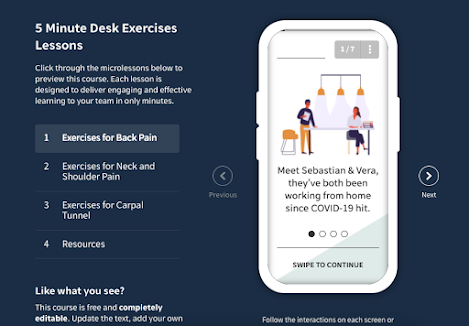Micro Learning - The best microlearning examples to inspire you for 2021 (Elucidat)
Greany, K. (2019, September 7). The best microlearning examples to inspire you for 2021. Elucidat. https://www.elucidat.com/blog/microlearning-examples/
How can I use this?
- explain rationale for using micro learning
- simple framework for realizing micro learning
- situation, seek, share
- other
- 20 seconds of theory,
- 3-4 in-depth demos,
- a “how to”
- some expert tips
- 6 example frameworks
Why must I use this?
- facilitates design
- has concrete examples
When will I use this?
- ideal for supporting writing project / generic .. presentation project
What is microlearning?
Microlearning is a way of providing short, focused pieces of content to an audience, ideally where and when they need it. It’s not a new idea, and its effectiveness has been debated within the learning and development industry. Bite sized courses don’t necessarily equal good learning or improved performance, as we’ve argued before. However, in the right context and done with the overall experience in mind, it can be highly effective.
Ok what context?
Where done with overall experience in mind?
Why consider microlearning?
In a world where people are checking their smartphones 9 times an hour, and competition for attention is now extra fierce, it’s no wonder that shorter digital learning content is becoming more popular.
Modern workplace learners want to access elearning courses on mobile devices, on the move and in stolen pockets of time – on trains, over breakfast, before meetings. If you want to gain traction for your content, you should consider how to target those tiny windows of opportunity.
However, it’s key that microlearning isn’t used as a vehicle to deliver lots of content randomly. That would misuse the small amounts of time modern learners have and disable the learning from sticking. Here are some ways to deliver microlearning, smartly.
1 - a collection of related topics to help the audience access help as and when they need it.
- many topics listed as tiles
- each topic
- 20 seconds of theory,
- 3-4 in-depth demos,
- a “how to”
- some expert tips
- choose a topic
- write research questions
- find sources
- list references
- annotate sources
- take notes
- write outline
- write 1st draft
- review
- write final draft
- format final draft
- submit final draft
- Practical tasks are broken down into clear, simple steps, making it easy for new staff to get up to speed in a short amount of time
- Video demonstrations and checklists provide further support
- In-page navigation makes it simple for learners to complete each section of the page
- The scrolling design makes it easy to refer back to the content on mobile devices
- group work roles
- public speaking
- listening
- Situation – Got a flat tire.
- Seek – Look up how to fix it.
- Solution – Fix it.

Comments
Post a Comment